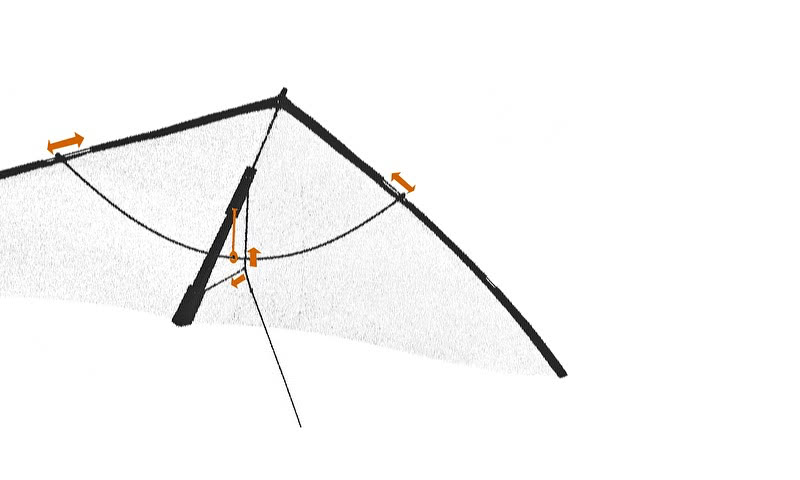Adjustments on small kites
Small single line zero-wind kites can be adjusted for flying indoor or outdoor in larger space, and for high flights in some wind also. Setups for diverse flight characteristics of your small kites: bridle, leading edge connectors, z-line and sail.
The i'll be back, the c'est la vie darling, urban ninja the numbers and also the sticky 3.7 are built a bit reduced compared to the other synergetic zero-wind kites: there's no Y-Line. This line sets the effective length of the X-Line and thus the tension or better the slack of the whole sail.

Still, there are the remaining setups:
The bridle set to heavy for relaxed, stable flights or set to light, resulting in agile, reactive flight characteristics.
A shorter Z-Line (3 loops around the spreader) will stabilize the straight gliding by increasing the dihedral. With a longer z-line (1 loop) the now flatter kite will perform rather lively glides. The standard setup of the Z-Line is always 2 loops around the spreader, on any of our kites.
While adjusting the Z-Line, the sail tension is usually compensated by the Y-Line. What to do with the small zero wind kites?
Shifting the leading edge connectors
The default position of the spreader-wing-connectors is indicated on the sail by the black mark. Or exactly: the X-Line between stopper and connector is facing the mark. This is standard on all our kites, viewed perpendicular to the leading edge.
Shifting the stoppers up (towards the nose of the kite) increases the effective length of the X-Line, tensioning the sail a bit. The compact kites will glide faster. Or too fast, especially if they are new.
Shifting the stoppers downwards will shorten the effective length of the X-Line, the sail will be relaxed, nice. The compact kites will glide slower, floating well balanced.
Sliding these stoppers up or down is also handy to fine tune the symmetry of a kite. In rare cases you can also intentionally set a tendency to turn in one direction, e.g. for special indoor flights.
Tension along the spine
This time very simple and for any kite: The more slack the sail is along the spine area (the tension between nose and stern), the calmer your kite will fly, whether big or small, delta- or wing-shaped.
If you tighten the line at the nose a little until the sail is under a slight tension, the kite will become more agile as it will lift the nose faster. After a flatspin it's immediately ready to rise again.
The sail of the small kites
A brand new small Horvath-Kite is a bit too fast because the even, planar Icarex fabric or Dyneema laminate is not able to touch a lot of air yet. That's why sometimes the leading edge connectors are a few millimeters below the mark on the sail, out of factory.
It's good for any of our kites to hang it up into the wind for an hour or two to get a soft, smooth sail. Some rustling sound is ok. When done, you will slightly move the connectors to find your preferred, balanced flight characteristics.